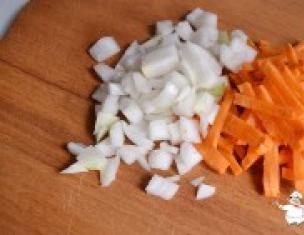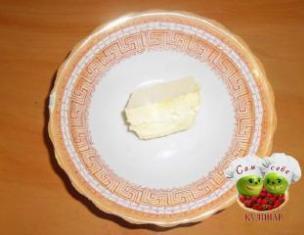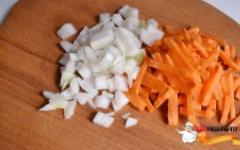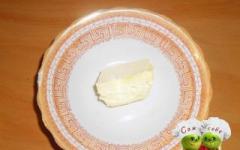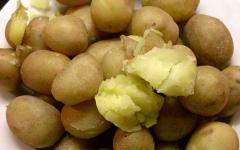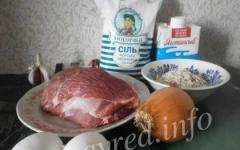Vinegar is the end result of the fermentation process, the destruction of sugar by yeast bacteria, which is contained in the original product. First, alcohol is obtained from sugar, and if the fermentation process is not stopped, then in the future alcohol becomes vinegar.
As a raw material for vinegar, you can use fruits, vegetables, grains. From apples produce apple vinegarwhich has found wide application not only in cooking, cosmetology, but also in traditional medicine. It is even called the cure for all diseases. Such a widespread use of this product is explained by the content in it: potassium, calcium, iron, amino acids, boron, etc.
For the industrial preparation of vinegar as raw materials use apple peel, core and apple cake, which remain as waste in the production of juices, jams and jams. In homemade recipes, whole apples, apple juice and cake are used, which makes homemade vinegar richer in nutrients.
Additionally, it is possible to enrich homemade apple cider vinegar with useful macro- and microelements if honey is used to make it instead of sugar. This beekeeping product makes the end product rich in potassium. For the first time such a recipe for the preparation of vinegar was proposed by an American doctor, Dr.-S. Jarvis
If after cooking, you still have apples, be sure to cook apple cider vinegar in one of the following recipes.
Homemade Apple Cider Vinegar: A Simple Recipe
There are many recipes for cooking apple cider vinegar at home. They differ not only in the ingredients needed for preparation, but also in the duration and complexity of the preparation steps.
The following recipe is simple in every sense. It will require only 3 ingredients and 4 weeks to prepare, but first things first.
Ingredients:
- apples - 1 kilogram,
- sugar - 50 grams for sweet apples or 100 grams for sour,
- water - about 1 liter.
- Apples wash and prune all spoiled places. Then, together with the peel and core, cut into not very small pieces and fold into glass, enameled or earthenware.
- Add sugar to apples.
- Boil water, cool to 70 degrees and pour apples.
- Remove the container in a dark and warm place for 2 weeks, not forgetting to stir the contents 2-3 times a day.
- After 14 days, gently strain the liquid through 3 - 4 layers of gauze into a glass jar, not filling up to the edges 5 - 7 centimeters.
- Cover the jar with several layers of gauze and put it back in heat for another 2 weeks.
Ready apple vinegar strain and bottle, not razmoltav sediment at the bottom of the jar. Bottles tightly corked.
A simple recipe for apple cider vinegar from the cake
After preparing the preservation of apples (eg, juice) remains cake, which can be used for apple cider vinegar. The only disadvantage of this recipe is that it will be difficult to filter a very small cake.
Ingredients:
- fresh apple cake - 1 kilogram,
- sugar - 0.5 cups,
- water - 1.5 liters.
Cooking sequence:
- In a glass jar with a wide neck to fold the cake, sugar and pour warm boiled water. Water should be a few centimeters above the cake.
- Cover the jar with several layers of gauze and store in a dark and warm place for 60 - 90 days.
- Over time, drain the finished vinegar, strain through cheesecloth and pour into bottles for storage.
Apple juice vinegar
Get the most light apple cider vinegar from apple juice. Juice for vinegar should be without cake. To prepare it, you can use the juicer.
Ingredients:
- apple juice - 3 liters.
Cooking sequence:
- Apple juice is poured into a 4 liter bottle. Wear a medical glove on the throat of the jar and leave to ferment for 4 weeks in the heat. If the glove breaks during this time, then replace it with a new one.
- After a month, pour the contents into an enameled pan with a wide bottom, cover with several layers of gauze and leave to wander for another 1.5 - 2 months.
- When the sharp unpleasant smell disappears, the vinegar is ready.
Stored homemade apple cider vinegar is stored in tightly closed glass bottles at a temperature of 5 to 25 ° C. The ideal place to store it is the refrigerator door or shelf in a cool pantry. Shelf life homemade vinegar 2-3 years.
Here we will talk about natural apple cider vinegar, which should be made from finely chopped whole apples. The stores sell ready-made apple cider vinegar, but in industry it is usually made from the peel and core of an apple. Therefore, it is better to cook apple cider vinegar yourself. His recipe is pretty simple.
In the process of making vinegar, apple juice is diluted almost twice, as a result of which the amount of potassium in it decreases. Therefore, it is recommended to add to vinegar not sugar, but honey, which restores the potassium deficiency. 50 g of sugar or honey (for 800 g of apples) should be added to apples of sweet varieties, 100 g of the same weight should be added to sour apples. It is believed that honey is useful to add. Potassium in the human body is associated with silicon, iron and a number of elements. So, this connection is due to vinegar. If you eat just an apple, then such chemical processes will not go - others will go.
Natural or synthetic vinegar?
Natural apple cider vinegar is significantly more expensive than synthetic - two or more times. The strength of natural apple cider vinegar is 4-5%, and synthetic - as a rule, 9%. You need to be absolutely sure that really natural apple cider vinegar is bought, and not a flavored chemical vinegar. Excessive consumption of synthetic vinegar leads to sand and kidney stones, gastric ulcer and duodenal ulcer, acute nephrosis and nephritis.
Store apple cider vinegar is not suitable for diet. Only made from top-quality green apples with their own hands.
Subtleties
Muddy vinegar can be used. Over time, the sediment will fall down.
Yeast when cooking can not add.
Vinegar in the bank wanders longer than in a bowl or a bastard because of the small area of contact with air.
Vinegar is a fermented juice. The juice and vinegar are completely different. chemical compounds.
The shelf life of apple cider vinegar is approximately two years. Have different varieties Vinegar shelf life may vary. If you bought apple cider vinegar in a store or pharmacy, then the expiration date will be indicated on the package.
First rehearsal
It is necessary to take over-ripe apples or carrots, so that they are grown without fertilizing trees with chemical fertilizers, not treated with harmful chemicals. There are such apples now, in the autumn, very, very much in any village. People do not know what to do with them. Apples need to be washed, cut smaller or crushed. Then put into an enameled pan with a wide bottom, pour hot water (65-70 °).
For 1 kg of sweet apples add 50 g of sugar, for sour - 100 g. I think that sugar can be replaced with honey. Water should be 3-4 cm higher than the level of apples. Put the dishes in a warm place, but not in the sun. It is often necessary to mix the mass so that it does not dry out from above.
After two weeks, strain the liquid through gauze folded in 2-3 layers, pour into large cans for fermentation. It is better not to top it up to 5-7 cm. Let it stay warm for another two weeks.
Without shaking, ready vinegar is poured into bottles, without adding to the very edge. Strain the precipitate through a thick cloth. Bottles corked. If you have to keep for a long time, pour the plugs with paraffin. Store in a dark place at a temperature of 4 ° to 20 °.
Second recipe
Apples grate on a coarse grater. Raw apple gruel put in a glass jar and dilute with warm boiled water (800 g gruel 1 liter of water). For each liter of water add 100 g of honey or sugar, and to speed up the fermentation - 10 g of yeast or 20 g of dry rye bread. The first 10 days to keep the vessel with this mixture open at a temperature of 20 - 30 ° C, stirring apple gruel with a wooden spoon 2 to 3 times a day. Then put the mass in a gauze bag and squeeze the juice. Strain juice through cheesecloth and pour into a jar with a wide neck. If desired, add 50 - 100 g of honey or sugar to 1 l of juice. Close the jar with gauze, tie it up and put it in a warm place so that the fermentation will last another 40 to 60 days. Then filter the vinegar, bottled and tightly close them with traffic jams. Store in a refrigerator at a temperature of 6 - 8 ° C.
Third recipe
Wash apples, remove rotten and bloody places, then squash or rub on a pile of rye (skin and cores are also used). Pour syrupyy gruel with warm boiled water (1: 1, that is, per kg of gruel - liter of water), add to each liter< 100 гp меда или сахаpа, а также (для yскоpения бpожения) по 10 гp хлебных дpожжей и 20 г сyхого чеpного хлеба. Сосyд с обpазовавшейся смесью хpанить откpытым пpи темпеpатypе 20-30 гpадyсов, он (сосyд) должен быть из стекла, деpева или эмалиpованной глины, хpаниться в темноте, т.к. солнечный свет пpепятствyет бpожению. В тепле надо деpжать где-то 10 дней, кашицy помешавают деpевянной ложкой 2-3 pаза в день, затем выжимают в маpлевом мешочке. Оставшyюся жидкость пpоцеживают чеpез маpлю, опpеделяют вес и пеpеливают в сосyд с шиpоким гоpлышком. Hа каждый литp снова добавляют 50-100 гp меда или сахаpа, хоpошо пеpемешивают; сосyд закpывают маpлей и хpанят в тепле для пpодолжения пpоцесса бpожения. Когда жидкость yспокоится и пpояснится, yксyс готов. Бpожение занимает пpимеpно 40-60 дней. Уксyс pазливают по бyтылкам, фильтpyя чеpез маpлю, и хpанят в пpохладном месте.
The recipe according to D. Jarvis
For 800g of apples (preferably Antonovka) - 1l of water, 150 ~ 200g of honey or sugar, 10g of yeast or 20g of dry rye bread. Wash apples, remove rotten and wormy parts and grate on a coarse grater along with the core.
In apple gruel pour warm boiled water, add honey or sugar and to accelerate the fermentation - yeast or rye bread.
Pour the resulting mass into a vessel with a wide neck - the larger the surface of contact of the liquid with air, the faster the fermentation will take place. The mass should be below the top of the vessel by 7 ~ 9 cm, since it will increase during fermentation and may overflow. The vessel should be glass, wood or clay. Open the vessel with the mixture in a dark warm place for 10 days, 2 ~ 3 times a day, mixing the gruel with a wooden spoon. After 10 days, squeeze the apple mass through gauze in several additions or through a dense cotton fabric.
For each liter of the resulting juice, add 50 ~ 100g of sugar or honey and again pour into a jar with a wide neck. Tie the vessel with gauze and put in a warm dark place for another 40 ~ 60 days. Fermentation is considered complete when the liquid stops boiling, brightens and stops being turbid..
Filter the finished vinegar, bottled, tightly close them with corks (you can fill the cork with wax). Store at t = 6-8 ° С. In bottles with apple cider vinegar in a few months a sediment may form - reddish flakes.
Fifth recipe
Looking for good ripe apples - i.e. the more fragrant the apples, the better in taste and aroma will be vinegar. It is important to remove all wormholes, rot.
At 400g. apples
500g of boiled water room temperature
100gr. Honey or sugar + 50-100gr then
20g. Black dried bread (piece)
Wash the apples well, cut all the black spots, chop into small pieces - but not quite puree (it will be difficult to strain), for example, in a chopper or on a large grater, straight with the peel and seeds.
Mix with honey (sugar), shift in 3 liter jar, add 2 slices of bread, pour water. At a 3-liter jar you need about 2.5 servings or look at the weight of apples. Fill the jar before narrowing, i.e. not up to the top. Top tie a gauze. Put the bank in a warm place with a pace of 25grad. for 10 days. Under the bank it is better to put a pallet just in case. Every day interfere 3-4 times - there will be an active fermentation process.
After 10 days, strain the vinegar, separating the apple mass and squeezing it (you can through gauze or through a caprice). Strain through 2nd gauze again. Add the second time honey or sugar, stir. Neck with gauze, put further in a dark place. It is not necessary to interfere with him any more, but just to observe There is a quiet fermentation and transformation into vinegar. A thin layer of mold may appear in the process - just remove it with a spoon, this is normal. Readiness of vinegar is considered - when it became completely transparent, like a tear. Cooking time depends on apples and temp-ry. This recipe makes 6% vinegar. After the finished vinegar is poured into glass bottles, it is closed and stored in a cool place. Pour gently, it is better through a tube, so as not to raise the sediment. After 6-10 months, he can strengthen up to 9% - but all beneficial features his remain. Stored until the next apple harvest, i.e. year for sure.
You can do this: in a small bottle of 0.5 l I throw garlic, dill buds, peppercorns, any dry herbs, pour vinegar - it turns out an excellent dressing for salads or for pickling meat. A couple of weeks fragrant vinegar is ready. Strain out then do not need anything. The smell is unmatched!
Purchased juice and vinegar
Is it possible to make apple cider vinegar from simple apple juice bought in a store? Answer: not. There are a lot of preservatives. Juice does not ferment, and dies.
What is the acetic womb
The main component of apple cider vinegar is fermented apple juice. The sweeter the apples, the higher the alcohol content in the wort and the easier it is to form acetic acid.
At the top of the vinegar, a thick, whitish, foamy film may be formed, which is called an acetic womb or a film of yeast-like fungi. The healing properties of this film are three times the healing properties of apple cider vinegar itself.
Sometimes in the raw material can enter the "acetic uterus" - the most valuable in vinegar. So called foam or mucous mass, which can be seen on the surface of apple juice or wine when they wander. The "acetic uterus" has three times more healing properties than vinegar, and even relieves those diseases where ordinary apple cider vinegar does not work (for pain in the joints, infection of worms, skin lesions).
"Acetic womb" is quite capricious. Sometimes they die if the vessel with the fermented juice is moved to another place.
This film is sometimes smooth, delicate and thin, now dense, solid, gathered in many numerical folds, which completely cover the entire surface of the wine. The wine under the film often remains completely transparent at first, but with the development of the disease, when the old layers begin to come off and settle to the bottom, the wine becomes cloudy.
The acetic womb looks like swollen gelatin - monolithic, slightly transparent. If the vinegar is stored for several years, the uterus can take up the entire volume of the dish. But from it you can squeeze some vinegar.
Addition:
Foamy film or mucous mass on the surface of vinegar is not a mold, but a very valuable and useful formation, called the "acetic womb." It is considered a miracle cure, one spoon of which can relieve the patient's condition even in cases where the vinegar does not help. This tool is used for increased susceptibility to infections, pains in the joints and painful rashes on the skin. If you are not deterred by the somewhat unusual look and texture of the "acetic uterus", eat only a spoon in order to feel its beneficial effect on yourself.
The benefits of natural apple vinegar
Apple cider vinegar contains malic acid, which, when combined with alkaline elements and minerals in the body, is converted to glycogen. Apple cider vinegar increases blood clotting, restores the menstrual cycle, contributes to the work of blood vessels and the formation of red blood balls. It contains a large amount of potassium necessary for the normalization of the nervous system.
53Health 10/28/2014
Irina28.10.2014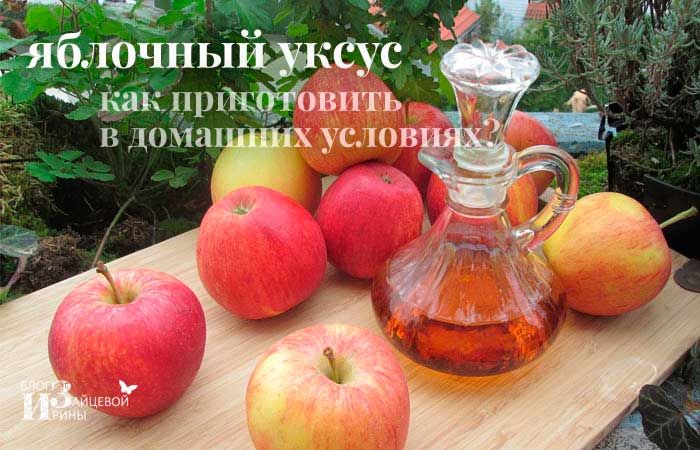
Dear readers, today we will talk about cooking a homemade apple bite at home. Why am I on the blog decided to touch on this topic? Information and benefits of apple vinegar is now very much. It is no coincidence that Cleopatra took him to preserve her beauty and health. And on the shelves of stores, he is now represented in a large assortment. But what can we buy in the store? Agree, often just chemistry ... I suggest we all still have wisdom, some knowledge, do not be lazy and cook apple cider vinegar at home. It will serve us not only as a food product, but also to have really beneficial healing properties.
Such vinegar, made from apples, is known for a very long time, it was used in antiquity not only in cooking and for cosmetic purposes, it was kept in a first-aid kit as a medicine for various ailments. Can we not find time today and cook everything at home by ourselves?
Apple cider vinegar at home. How to cook?
Unfortunately, there are a lot of fake goods on the shelves of our stores, I do not exclude that apple cider vinegar, which is sold, is far from natural. Therefore, it is not surprising that many people began to cook this product themselves, especially those who have their own orchards and apples. This season also pleased us here.
Natural vinegar is natural because it is made exclusively from apple juice with a small amount of honey or sugar. The juice in the manufacturing process is fermented and alcohol is obtained, and already with further processing acetic acid is formed. It is best to use sweet varieties of apples for these purposes, they give a greater amount of alcohol and do not require a lot of sugar.
You can make homemade apple cider vinegar from whole fruits or juice, I suggest to consider different ways making it.

Apple vinegar homemade. How to cook? Recipes
Making homemade apple cider vinegar is not so difficult, it only seems that the process is incredibly complicated, in fact, everything is quite simple, only time is needed. Described in various literature many ways to prepare this unique product, it can be prepared exclusively from sweet juice without adding sugar, you can add sugar, honey, rye sourdough bread, the easiest way to use the whole fruit, without squeezing the juice, let's look at several recipes I know.
The first recipe for homemade apple cider vinegar at home
1. For this recipe, take one and a half kilograms of apples, rub them on a coarse grater whole, without throwing out the core, put them in a glass jar or enameled vessel and fill with two liters of boiled cold water.
Next you need to put in a container a piece of black rye bread, about 50 - 60 grams, and add 150 grams of natural bee honey. Put it on the table, do not cover it with a lid, but just cover it with a towel or gauze cloth on top, keep it warm for about 10-12 days, apples should ferment during this time. Then strain the entire contents through gauze into another container and now let it stay longer, usually a month, then finally strain and bottle. All vinegar is ready, the bottles are closed and stored in a dark place. This is the easiest recipe I know.
The second recipe for homemade apple cider vinegar at home
2. In the second recipe, we do everything a little differently, take two kilograms of apples and 1.5 liters of pure, but raw water, for sweet apples we take one hundred grams of sugar, and for sour ones, three hundred grams.
Apples fit any variety, they need to be grated on a coarse coarse ground together with the peel and seeds, as in the past recipe, lay in an enamel pan and cover with water, adding half of the sugar and mix everything well.
You need to cover the pot with something, you can just use a towel or a napkin, but not a lid, since the mass should ferment in the presence of air, and let it cost three weeks. All this time, the apple mass must be stirred with a wooden spoon.
After three weeks, strain the mass, add the remaining sugar, mix to dissolve, and pour into the jars. Cover the cans with a towel on top and leave for a month and a half to two months again to continue the fermentation process. All this will seethe, but with time the liquid will brighten, then it will become transparent, which means that the fermentation process is completed, and the vinegar is ready for use ..
After that, the vinegar is again filtered and bottled. Store it preferably in a cool place in a closed form.
Vintage recipe for apple cider vinegar at home
3. Here is another old recipe, too, is simple, overripe apples will do for him, they need to be thoroughly washed, chopped and cut. Put the gruel in an enameled pan and pour hot water (about 70 degrees), pour water so that it not only closes the apples, but also is several centimeters higher. Sugar is added at the rate of 50 grams per kilogram of sweet apples and 100 grams per kilogram of sour apples.
Put the pot somewhere where it is warm and dark, not forgetting to stir the contents from time to time. After two weeks, everything is good to filter and pour into jars with a wide neck, but not to the top, for further fermentation.
After two weeks, homemade apple cider vinegar is ready, it needs to be finally poured into the container, in which it will be stored, drained, without agitation, and filter the sediment, stored in a cool place.
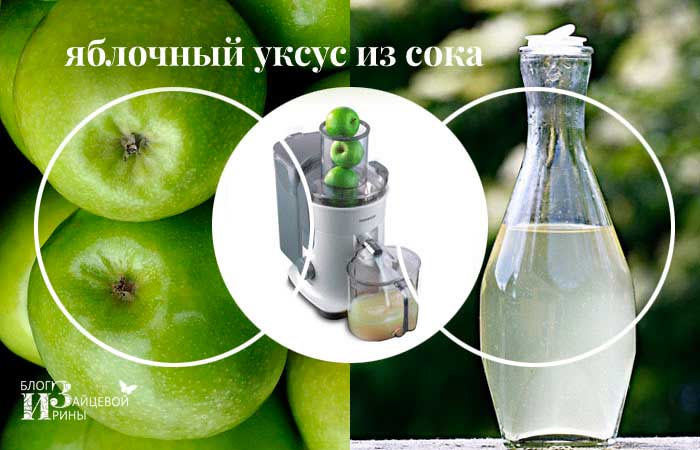
Apple cider vinegar. Homemade recipe
It is possible and in another way to make apple cider vinegar at home, for this you need to squeeze out the apples juice through a juicer, it should be without pulp. Yeast and sugar can not be added, but to speed up the process, it is better to take quite a bit of dry yeast, about a quarter of a teaspoon, add a teaspoon of sugar and dilute in a small amount of warm water, this will make us a sponge. When the opara begins to foam and rises a little, it is poured into a container with juice. To speed up the fermentation process, you can also put a crust of rye bread in a bowl with juice.
A medical glove is usually worn on the neck to prevent air from entering the vessel. The carbon dioxide that forms during the fermentation process will gradually fill the glove, and if it breaks, you need to wear a new one, so the juice should last four weeks, during which time the fruit sugar will completely turn into alcohol.
Apple cider vinegar is used for cooking as often as its fellows: wine and balsamic vinegars. This type of vinegar is used in broths and dishes from fish, poultry, seafood.
With the help of apple cider vinegar, the tastes of many drinks and sauces are more pronounced. With it, pickled vegetables, garlic, hot peppers, olives. This vinegar is used in baking. For example, based on it make some types of puff pastry. They fill it with salads and it is quite possible to use it instead of lemon juice.
Natural vinegar is also used for health and beauty purposes, they remove stubborn stains from furniture and clothing. Today we will tell you how to cook apple cider vinegar at home and give 3 recipes.
What is Apple Vinegar
Apple cider vinegar is a completely natural product. It is obtained by fermentation of apple juice without the addition of chemical additives. In this transformation from sweet juice to sour vinegar, the useful properties of apples are not lost, and even new useful properties are added due to the appearance of organic acids.
Due to its naturalness, this vinegar may have sediment at the bottom of the bottle, this applies even to the product purchased. When buying, read the data on the composition, in vinegar should not be anything other than water and malic acid. Store vinegar should not exceed 6%.
The benefits of apple cider vinegar
Apple cider vinegar contains useful pectin, vitamins of groups A, B, E, C, R. Organic acids that appear during fermentation are citric, malic, lactic, oxalic. This type of vinegar is rich in fluorine, iron, silicon, phosphorus, potassium, calcium, sodium, copper.
Thanks to these vitamins, acids and microelements, apple cider vinegar helps to normalize pressure, regulates blood clotting, soothes the nervous system, promotes normal digestion, breaks down fats, tones the skin and improves its appearance, eliminates slagging.
It can be used as a gargle for sore throat, a mixture for rubbing at high temperature, with mosquito bites, fungi, and migraines. They can rinse hair, making them more obedient, wipe your face with acne.
Several subtleties of cooking
- Choose only good, strong apples, without rot and wormholes. It is advisable to give preference to sweet varieties. The speed of formation of acid depends on the sweetness of apples.
- It is good to replace sugar, if it is in the recipe, with honey.
- Acetic foam will appear during fermentation. This is the most useful in apple vinegar, you can not remove it, but you need to constantly mix with the main liquid.
- A full cycle of cooking vinegar will be about 2 months.
- Pour juice or preparing vinegar in the container, leave at least 10 centimeters of free space.
- Mix vinegar and apples with a wooden spoon.
- Do not cook vinegar in plastic dishes, cook only in glass or clay dishes.
- The best place to make vinegar is a hot battery storage room.
- In the first phase of fermentation, it is better not to mix apple juice and not to touch it at all.
- It is better to close the resulting vinegar in bottles with natural material stoppers.
- We recommend to store vinegar in the temperature range from +6 to -15 degrees.
The easiest recipe for vinegar
Ingredients:
- Apples 2 kg
- Wash fruit, dry and cut into quarters. Leave them to lie in a bright place until a noticeable darkening.
- Squeeze the juice out of the apples.
- Pour the juice in the container, where the vinegar will be prepared, close the neck with a rubber glove and secure with string.
- Leave the container in a warm, dark place before the glove swells up strongly (about 5 weeks).
- Pour the vinegar into another container, cover the neck with a cotton towel or cork and put in place.
- After about 7-8 weeks, the vinegar will be ready, it will become completely transparent.
- Cover the tank with a cotton towel and set it in a warm and dark place for 10 days, stirring several times a day.
- Pour into another container, add the remaining honey, mix, cover with a towel and set for another 1.5-2 months. No need to mix.
- Over time, the transparent vinegar is filtered and poured into bottles.
Amazing apple cider vinegar is rich in a huge number of important vitamins and enzymes that have a beneficial effect on the digestive, cardiac, nervous and other systems of human activity. The product is used everywhere: in medicine, cooking, cosmetology. But not all the vinegar purchased in the store can have impressive healing properties, and therefore people are increasingly seeking to cook apple cider vinegar at home, studying the Internet in search of the best recipes.
How to make a natural vinegar?
There are only a few options for making a valuable product at home, which are improved and “matched” by each housewife to suit their taste preferences. Anyway, the product prepared with love turns out better and more useful, than in shops.
Recipe number 1. Classical
For the execution of this recipe will require a minimum of ingredients:
- 3 kg of quality (in no way Chinese!) Apples;
- boiled water;
- 300 g of sugar (100 g per 1 kg of apples);
- a lot of gauze or similar straining fabric;
- a large vessel with a wide throat or pan (wood, glass, enamelled, stainless steel can not be taken).
Tip: good apple cider vinegar does not work out of bad raw materials, so it’s better to choose fruits in proven markets or farm fairs. It's great if you have your own product. During the selection, attention should be paid to apples in which there were worms, since this product is 100% not subjected to excessive chemical treatment or feeding.
So, the exact technology of the classic recipe:
- Vinegar begins ... With apple cider! The prepared raw material is cleared from skin lesions, the core is cleaned.
- Pure fruits are finely chopped, you can use a grater or even a blender and a meat grinder. The result should be a mass with clear pieces, but similar to mashed potatoes.
- Apples are placed in a container, then sugar is put. All ingredients are mixed and filled with water, brought to 70 degrees. There should be enough water so that it “rises” above the apples by at least 2 cm.
- Next, the future vinegar is covered and cleaned in a dark place, the temperature in which is constantly not lower than 17 degrees and does not rise above 25. The first stage of fermentation will take 2 weeks. At this time, the liquid should be mixed at least 2 times a day so that oxygen freely touches each piece of mashed potatoes.
- After two weeks, the acetic base is filtered through gauze, carefully squeezing the remnants of the pulp.
- The container is again covered with a cloth and put back into the room. The second stage of cooking begins, during which apple cider vinegar “reaches” the desired state. It takes an average of 4 weeks to complete this process.
- The finished elixir acquires a clear, rich amber hue, as well as a great apple scent.
Important: in no case should the vessel with vinegar be closed with an iron, glass or wooden lid, otherwise the product will start to rot, losing oxygen! An ordinary gauze, napkin or cloth, which can be tightened with a rope or an elastic band, so that it does not sleep and does not open access for dirt or insects, is suitable for this purpose.
Keep finished product better in prepared glass bottles, tightly closed lids. The ideal storage place is the fridge.
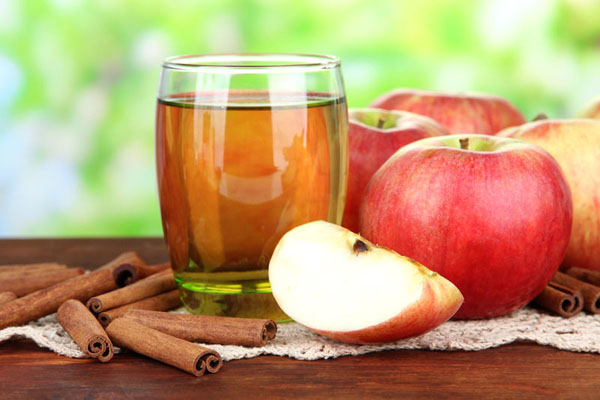
Recipe number 2. Fresh Juice Vinegar
Very simple recipe, relevant for happy owners of juicers. Or in the event that a large amount of apple juice remains, which was not useful anywhere, but it is a pity to throw it out. Ingredients:
- 1 liter of natural juice;
- 100 g of natural honey.
Cooking:
- Fresh juice is poured into a glass or enameled container.
- Honey is added and everything is thoroughly mixed so that there is no residue of the sweet substance.
- The jar is closed with gauze.
- Clean the vinegar base in a dark place for two months. During the fermentation process, the juice-based product does not require mixing. Important conditions to receive quality product - this is fresh air. Dark place must be aired. Ideal placement of capacity somewhere in the shade of the bushes in your own garden.
- After the expiration date, the finished vinegar is poured into bottles, without filtering.
- You can store in the refrigerator, if space permits, but you can in any other room with normal temperature.
Tip: In the process of making apple vinegar vinegar, a film of mold may form. This is a normal reaction, and not indicative of the fact that the product is spoiled. It is also not necessary to get rid of it, it will dissolve itself in the finished elixir.
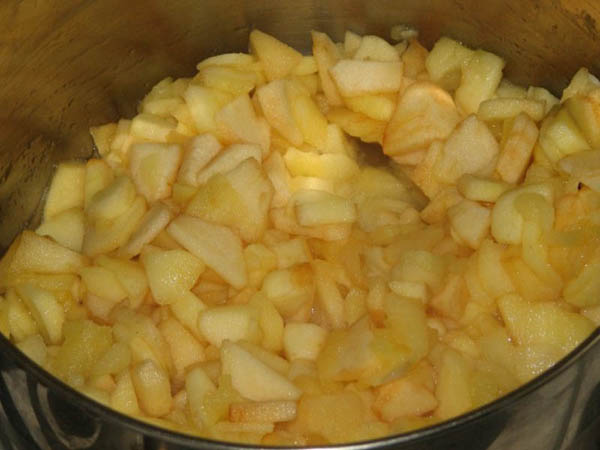
Recipe number 3 Honey and Yeast
One of the most difficult recipes that requires a large number manipulation, but apple cider vinegar for it turns out amazing. The structure includes:
- about 800 g of prepared apples (peeled);
- 1 liter of boiled water;
- 0.2 kg of natural, best of all - Siberian, honey;
- 40 g dry black bread (Borodino without additives is the best choice);
- 20 g dry yeast;
- 100 g of sugar.
Tip: when choosing apples, it is better to pay attention to late autumn varieties characterized by high sweetness. This fruit gives more enzymes and beneficial substances vinegar, and the aroma of the final product is especially bright.
Stages of cooking:
- After the apples are washed and finely chopped, they are placed in a wide container (ceramics, wood, glass, all the same as in the recipe number 1).
- Fruits are poured with cooled water, honey, yeast are dissolved in this mass, and crumbled pieces of bread.
- Cover the container with one layer of gauze. If there is confidence that no insects will fall into the product, you can not cover at all. Vinegar is stored in a ventilated place at a temperature of not more than 30 degrees, but not less than 20.
- After 10 days, the whole mass, already slightly fermented, is squeezed out using gauze. It is necessary to squeeze out as much juice as possible from the vinegar base.
- The resulting extraction is sent to a vessel with a wide neck (bottles or jars, you can take decanters), about 2 tbsp. Is added. l Sahara. The container with apple cider vinegar is cleaned in a warm place and covered with gauze, tightly tying the neck.
- The cooking process takes about 60 days. When the vinegar gets a light and completely transparent shade, and a small sediment remains on the bottoms of the vessels, the cooking process can be considered complete.
- Through gauze or paper filters liquid is bottled. Vinegar is ready!
Ideal just such vinegar to combat digestive problems and excess weight. There is one useful and exceptionally simple drink recipe that can rid the waist of unwanted centimeters in just a few weeks. The main thing is to approach it systematically: 2 tsp is taken for 1 cup of filtered water. vinegar and 1 tsp. high-quality honey. "Potion" is drunk on an empty stomach for a few tens of minutes before meals 2-3 times a day for the purpose of losing weight, and once a day before breakfast - with a general health purpose.
These are the recipes for homemade apple cider vinegar. All of them are quite simple and do not require any special skills. Is that a stable memory: if you forget to strain the vinegar after a specified time, then it will spoil and turn into a substance that is dangerous and unsuitable for adding to dishes.



